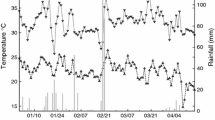Abstract
A venturi pipe part (VPP) allows air bubbles to be inserted into flowing water from air inlet holes and so increases dissolved oxygen (DO) levels in irrigation water. The DO helps the roots absorb nutrients at a faster rate, and can increase a plant’s growth rate by up to 30 %. Therefore, the aim of this paper is to evaluate design considerations and experimental results related to characteristics of VPP in air vacuum and aeration process. Optimal flow velocity in venturi inlet is determined between 1 and 4 m/s for aeration process. For starting of air vacuum process, minimum flow velocity is determined as 0.80 m/s. The ratio of the throat diameter of VPP to the inlet diameter of VPP equals to 0.5. Also, the ratio of the air vent diameter of VPP to the throat diameter of VPP equals to 0.3. Volumetric air flowrate decreases with increasing pipe length. In addition, the effect of aerated water on plant growth is tested with a case study. The case study is carried out on growth of the onion (Allium cepa) samples. In result of this test, aerated water is capable for plant growth of the onion (A. cepa) samples. However, it increased the plant’s growth rate by 27 %. Thus, irrigation projects can be planned with both VPP (AirJection Irrigation) and subsurface drip irrigation systems.

Similar content being viewed by others
References
Bhattarai, S.P.; Huber, S.; Midmore, D.J.: Aerated subsurface irrigation water gives growth and yield benefits to zucchini, vegetable soybean and cotton in heavy clay soils. Ann. Appl. Biol. 144, 285–298 (2004)
Bhattarai, S.P.; Pendergast, L.; Midmore, D.J.: Root aeration improves yield and water use efficiency of tomato in heavy clay and saline soils. Sci. Hortic. 108, 278–288 (2006)
Zhu, J.; Miller, C.F.; Dong, C.: Aerator module development using venturi air injectors to improve aeration efficiency. Appl. Eng. Agric. 23, 661–667 (2007)
Busscher, W.J.: Improved growing conditions through soil aeration. Commun. Soil Sci. Plant Anal. 13(5), 401–409 (1982)
American Public Health Association (APHA): Standard Methods for the Examination of Water and Wastewater. American Public Health Association, Washington (1980)
Benson, B.B.; Krause, D.: The concentration and isotopic fractionation of oxygen dissolved in freshwater and seawater in equilibrium with the atmosphere. Limnol. Oceanogr. 29, 620–632 (1984)
Vogelaar, J.C.; Klapwijk, T.A.; Lier, J.B.; Rulkens, W.: Temperature effects on the oxygen transfer rate between 20 and 55C. Water Res. 34, 1037–1041 (2000)
Gulliver, J.S.; Thene, J.R.; Rindels, A.J.: Indexing gas transfer in self-aerated flows. J. Environ. Eng. ASCE 116(3), 503–523 (1990)
Daugherty, R.L.; Franzini, J.B.; Finnemore, E.J.: Fluid Mechanics with Engineering Applications. McGraw-Hill Inc., New York (1985)
White, M.F.: Fluid Mechanics. McGraw-Hill, New York (1979)
Bagatur, T.: Technical note: minimal conditions for venturi aeration of water flows. Proc. Inst. Civ. Eng. Water Manag. 158(WM3), 127–130 (2005)
Baylar, A.; Emiroglu, M.E.: Air entrainment and oxygen transfer in a venturi. Proc. Inst. Civ. Eng. Water Marit. Energy 156(WM3), 249–255 (2003)
Emiroglu, M.E.; Baylar, A.: Study of the influence of air holes along length of convergent–divergent passage of a venturi device on aeration. J. Hydraul. Res. 41(5), 513–520 (2003)
Baylar, A.; Ozkan, F.; Ozturk, M.: Influence of venturi cone angles on jet aeration systems. Proc. Inst. Civ. Eng. Water Manag. 158(WM1), 9–16 (2005)
Ozkan, F.; Ozturk, M.; Baylar, A.: Experimental investigations of air and liquid injection by venturi tubes. Water Environ. J. 20(3), 114–122 (2006)
Baylar, A.; Ozkan, F.: Applications of venturi principle to water aeration systems. Environ. Fluid Mech. 6(4), 341–357 (2006)
Baylar, A.; Ozkan, F.; Unsal, M.: On the use of venturi tubes in aeration. CLEAN Soil Air Water 35(2), 183–185 (2007)
Baylar, A.; Unsal, M.; Ozkan, F.: Determination of the optimal location of the air hole in venturi aerators. CLEAN Soil Air Water 35(3), 246–249 (2007)
Baylar, A.; Ozkan, F.; Unsal, M.: Effect of air inlet hole diameter of venturi tube on air injection rate. KSCE J. Civ. Eng. 14(4), 489–492 (2010)
Bhattarai, S.P.; Su, N.; Midmore, D.J.: Oxygation unlocks yield potentials of crops in oxygen-limited soil environments. Adv. Argon. 88, 313–377 (2005)
Goorahoo, D.; Carstensen, G.; Zoldoske, D.F.; Norum, E.; Mazzei, A.: Using air in subsurface drip irrigation (SDI) to increase yields in bell peppers. Int. Water Irrig. 22, 39–42 (2002)
Author information
Authors and Affiliations
Corresponding author
Rights and permissions
About this article
Cite this article
Bagatur, T. Evaluation of Plant Growth with Aerated Irrigation Water Using Venturi Pipe Part. Arab J Sci Eng 39, 2525–2533 (2014). https://doi.org/10.1007/s13369-013-0895-4
Received:
Accepted:
Published:
Issue Date:
DOI: https://doi.org/10.1007/s13369-013-0895-4




